SERS Detection of Environmental Variability in Balneary Salt Lakes During Tourist Season: A Pilot Study
Abstract
1. Introduction
2. Material and Methods
2.1. Field Sampling of Waters
2.2. Sample Preparation for Raman and SERS Measurements
2.3. Silver Colloid Synthesis and Characterization
2.4. X-Ray Diffraction (XRD) Analysis of Salt Residues
2.5. Instrumentation
2.6. Data Processing and Statistical Analysis
3. Results
3.1. Physical and Chemical Characteristics of Surface Waters from Hypersaline Lakes
3.2. Raman Spectra of Raw Waters from the Two Lakes of Cojocna Balneary Resort During Summer Months from May 2023 to October 2023
3.3. SERS Spectra of Raw Waters from the Two Lakes at the Cojocna Balneary Resort During Summer Months from May 2023 to October 2023
3.4. X-Ray Diffraction (XRD) Analysis of Salt Baches
4. Discussion
4.1. Statistical Correlation Between Physicochemical Properties and Raman and SERS Signals of Lakes
4.2. Correlation Between Salinity and Conductivity of Lakes
5. Conclusions
Supplementary Materials
Author Contributions
Funding
Institutional Review Board Statement
Informed Consent Statement
Data Availability Statement
Conflicts of Interest
References
- Tran, N.H.; Li, Y.; Reinhard, M.; Goh, K.C.; Sukarji, N.H.B.; You, L.; He, Y.; Gin, K.Y.H. Quantification of Cylindrospermopsin, Anatoxin-a and Homoanatoxin-a in Cyanobacterial Bloom Freshwater Using Direct Injection/SPE Coupled with UPLC-MS/MS. Sci. Total Environ. 2020, 731, 139014. [Google Scholar] [CrossRef]
- Baricz, A.; Levei, E.A.; Șenilă, M.; Pînzaru, S.C.; Aluaş, M.; Vulpoi, A.; Filip, C.; Tripon, C.; Dădârlat, D.; Buda, D.M.; et al. Comprehensive Mineralogical and Physicochemical Characterization of Recent Sapropels from Romanian Saline Lakes for Potential Use in Pelotherapy. Sci. Rep. 2021, 11, 18633. [Google Scholar] [CrossRef]
- Ionescu, E.V.; Suta, M.; Surdu, O.; Oprea, C.; Stoicescu, R.M.; Taralunga, G.L.G. Clinical and Biological Effects Induced by Sapropelic Mud from the Lake Techirghiol in Patients with Osteoarthritis. J. Environ. Prot. Ecol. 2014, 15, 332–339. [Google Scholar]
- Katz, U.; Shoenfeld, Y.; Zakin, V.; Sherer, Y.; Sukenik, S. Scientific Evidence of the Therapeutic Effects of Dead Sea Treatments: A Systematic Review. Semin. Arthritis Rheum. 2012, 42, 186–200. [Google Scholar] [CrossRef]
- Şerban, G.; Alexe, M.; Touchart, L. Morphological Evolution and Salinity of Cojocna Lakes (Transylvanian Plain, Romania). Bull. d’Assoc. Geogr. Fr. 2005, 82, 234–245. [Google Scholar] [CrossRef]
- Krézsek, C.; Filipescu, S. Middle to Late Miocene Sequence Stratigraphy of the Transylvanian Basin (Romania). Tectonophysics 2005, 410, 437–463. [Google Scholar] [CrossRef]
- Molnár, C.; Drigla, T.D.; Barbu-Tudoran, L.; Bajama, I.; Curean, V.; Cîntă Pînzaru, S. Pilot SERS Monitoring Study of Two Natural Hypersaline Lake Waters from a Balneary Resort during Winter-Months Period. Biosensors 2023, 14, 19. [Google Scholar] [CrossRef]
- Li, Z.; Wang, J.; Li, D. Applications of Raman Spectroscopy in Detection of Water Quality. Appl. Spectrosc. Rev. 2016, 51, 313–337. [Google Scholar] [CrossRef]
- Cinta Pinzaru, S.; Ardeleanu, M.; Brezestean, I.; Nekvapil, F.; Venter, M.M. Biogeochemical Specificity of Adjacent Natural Carbonated Spring Waters from Swiss Alps Promptly Revealed by SERS and Raman Technology. Anal. Methods 2019, 11, 800–812. [Google Scholar] [CrossRef]
- Maškarić, K.; Cîntă Pînzaru, S.; Dumitru, D.-A.; Molnar, C. Raman Spectroscopy Techniques and Technology as a Tool in Environmental Water Analysis. In Proceedings of the 2024 “Air and Water—Components of the Environment” Conference Proceedings, Cluj Napoca, Romania, 21–23 March 2024; pp. 125–136. [Google Scholar] [CrossRef]
- Lee, P.C.; Meisel, D. Adsorption and Surface-Enhanced Raman of Dyes on Silver and Gold Sols. J. Phys. Chem. 1982, 86, 3391–3395. [Google Scholar] [CrossRef]
- Wei, T.; Simko, V. R Package “Corrplot”: Visualization of a Correlation Matrix (Version 0.84). 2017. Available online: https://github.com/taiyun/corrplot (accessed on 23 September 2025).
- Brezestean, I.; Nekvapil, F.; Cinta Pinzaru, S. Analysis of Hypersaline Waters from Cojocna Balneary Resorts (Romania) Using Raman Spectroscoy Techniques. In Proceedings of the Conference “Air and Water Components of the Environment”, Sovata, Romania, 15–17 March 2018. [Google Scholar]
- Müller Molnár, C.; Cintă Pînzaru, S.; Chis, V.; Feher, I.; Glamuzina, B. SERS of Cylindrospermopsin Cyanotoxin: Prospects for Quantitative Analysis in Solution and in Fish Tissue. Spectrochim. Acta Part A Mol. Biomol. Spectrosc. 2023, 286, 121984. [Google Scholar] [CrossRef]
- Cintə Pinzaru, S.; Müller, C.; Tomšic, S.; Venter, M.M.; Cozar, B.I.; Glamuzina, B. New SERS Feature of β-Carotene: Consequences for Quantitative SERS Analysis. J. Raman Spectrosc. 2015, 46, 597–604. [Google Scholar] [CrossRef]
- Bell, S.E.J.; Sirimuthu, N.M.S. Surface-Enhanced Raman Spectroscopy as a Probe of Competitive Binding by Anions to Citrate-Reduced Silver Colloids. J. Phys. Chem. A 2005, 109, 7405–7410. [Google Scholar] [CrossRef]
- Pinzaru, S.C.; Csilla, M.M.; Ioana, B.; Glamuzina, B. Cyanobacteria Detection and Raman Spectroscopy Characterization with a Highly Sensitive, High Resolution Fiber Optic Portable Raman System. Stud. Univ. Babes Bolyai Phys. 2016, 61, 99–108. [Google Scholar]
- Pinzaru, S.C.; Müller, C.; Ujević, I.; Venter, M.M.; Chis, V.; Glamuzina, B. Lipophilic Marine Biotoxins SERS Sensing in Solutions and in Mussel Tissue. Talanta 2018, 187, 47–58. [Google Scholar] [CrossRef]
- Müller, C.; Glamuzina, B.; Pozniak, I.; Weber, K.; Cialla, D.; Popp, J.; Cîntǎ Pînzaru, S. Amnesic Shellfish Poisoning Biotoxin Detection in Seawater Using Pure or Amino-Functionalized Ag Nanoparticles and SERS. Talanta 2014, 130, 108–115. [Google Scholar] [CrossRef]
- Josefson, M.; Walsh, A.; Abrahamsson, K. Imaging and Identification of Marine Algal Bioactive Compounds by Surface Enhanced Raman Spectroscopy (SERS). In Natural Products From Marine Algae, Methods in Molecular Biology; Springer: New York, NY, USA, 2015; pp. 365–374. [Google Scholar]
- Czellecz, B.; Gabor, I.; Ravasz, L.; Schiopu, G.; Szopos, N. Saline Water Resurces in Cluj-Napoca Surroundings. Air Water Compon. Environ. 2016, 408–415. [Google Scholar] [CrossRef]
- Alcorlo, P.; Baltanás, A.; Montes, C. Is It Possible to Predict the Salinity of Iberian Salt Lakes from Their Conductivity? Hydrobiologia 1996, 330, 137–142. [Google Scholar] [CrossRef]
- Bowman, J.S.; Sachs, J.P. Chemical and Physical Properties of Some Saline Lakes in Alberta and Saskatchewan. Saline Syst. 2008, 4, 3. [Google Scholar] [CrossRef]
- Anati, D.A. The Salinity of Hypersaline Brines: Concepts and Misconceptions. Int. J. Salt Lake Res. 1999, 8, 55–70. [Google Scholar] [CrossRef]
- Saccò, M.; White, N.E.; Harrod, C.; Salazar, G.; Aguilar, P.; Cubillos, C.F.; Meredith, K.; Baxter, B.K.; Oren, A.; Anufriieva, E.; et al. Salt to Conserve: A Review on the Ecology and Preservation of Hypersaline Ecosystems. Biol. Rev. 2021, 96, 2828–2850. [Google Scholar] [CrossRef]
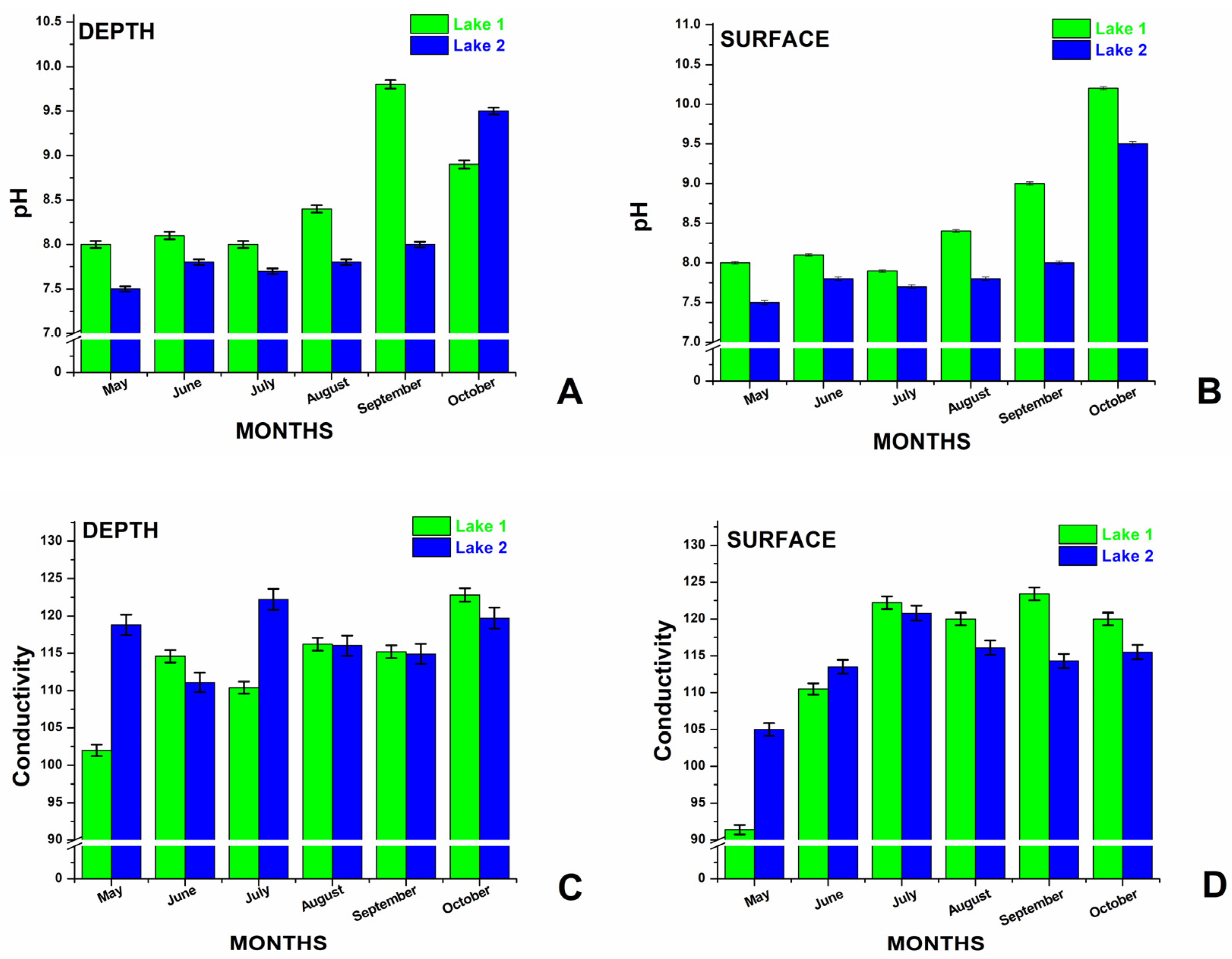
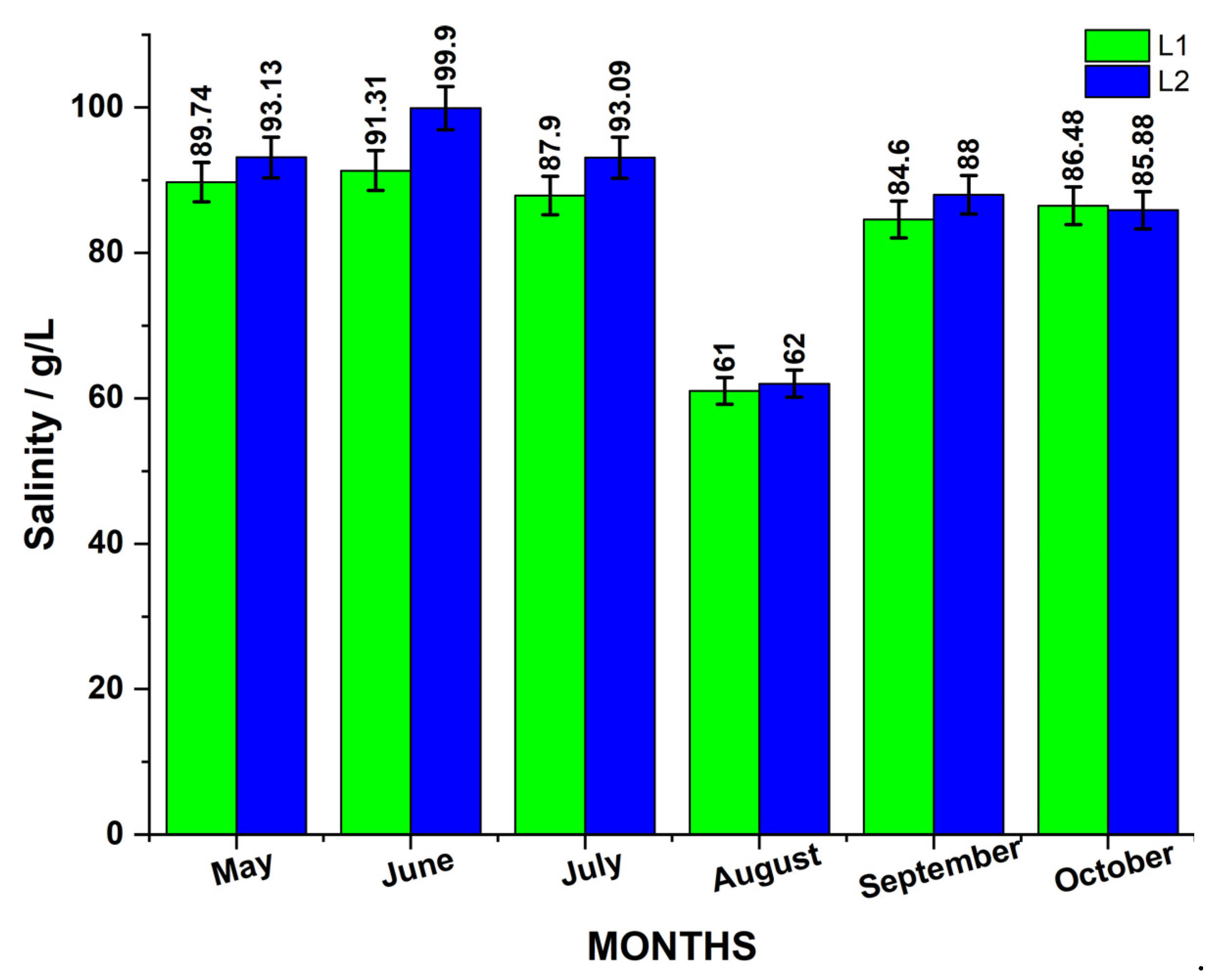
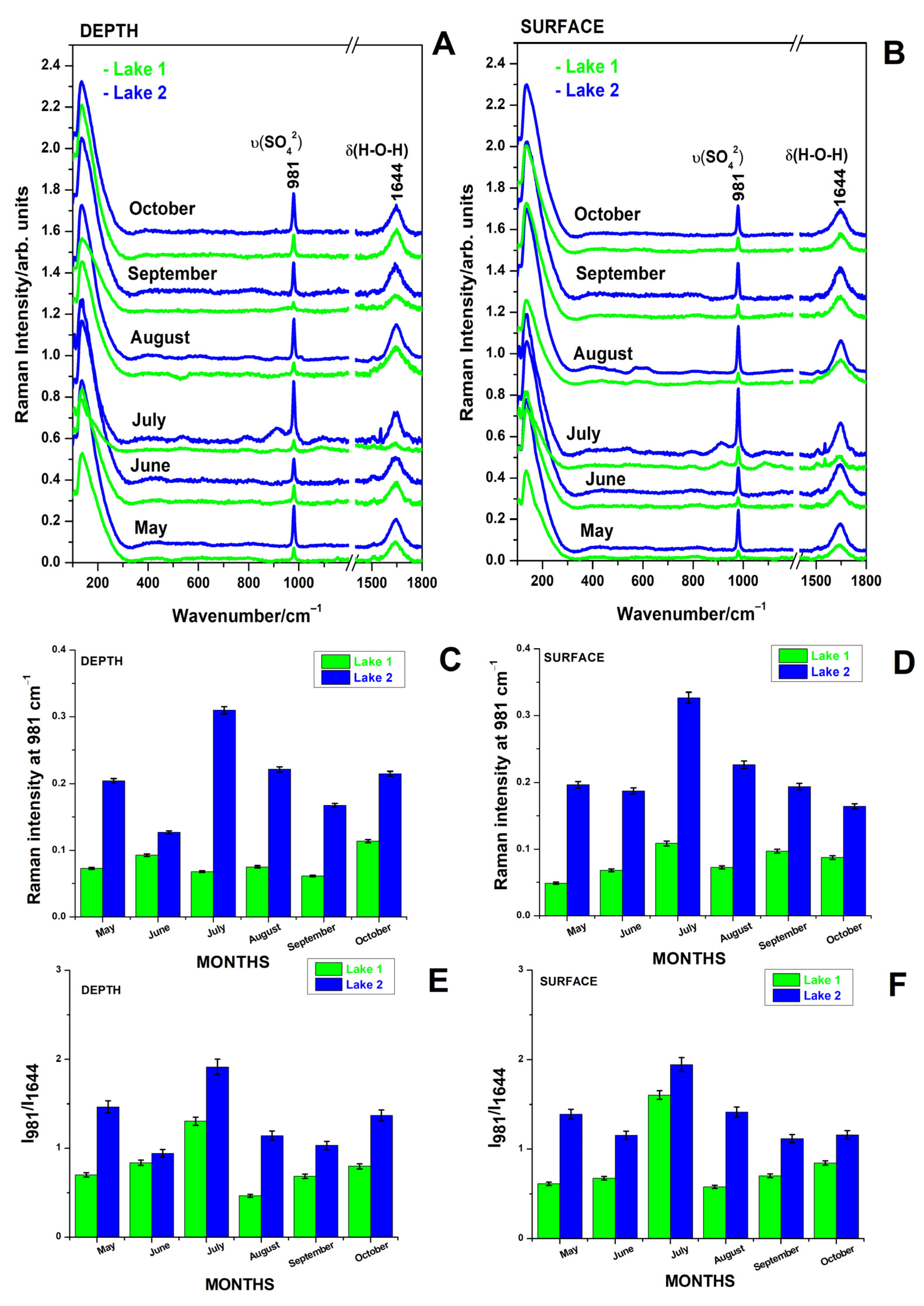
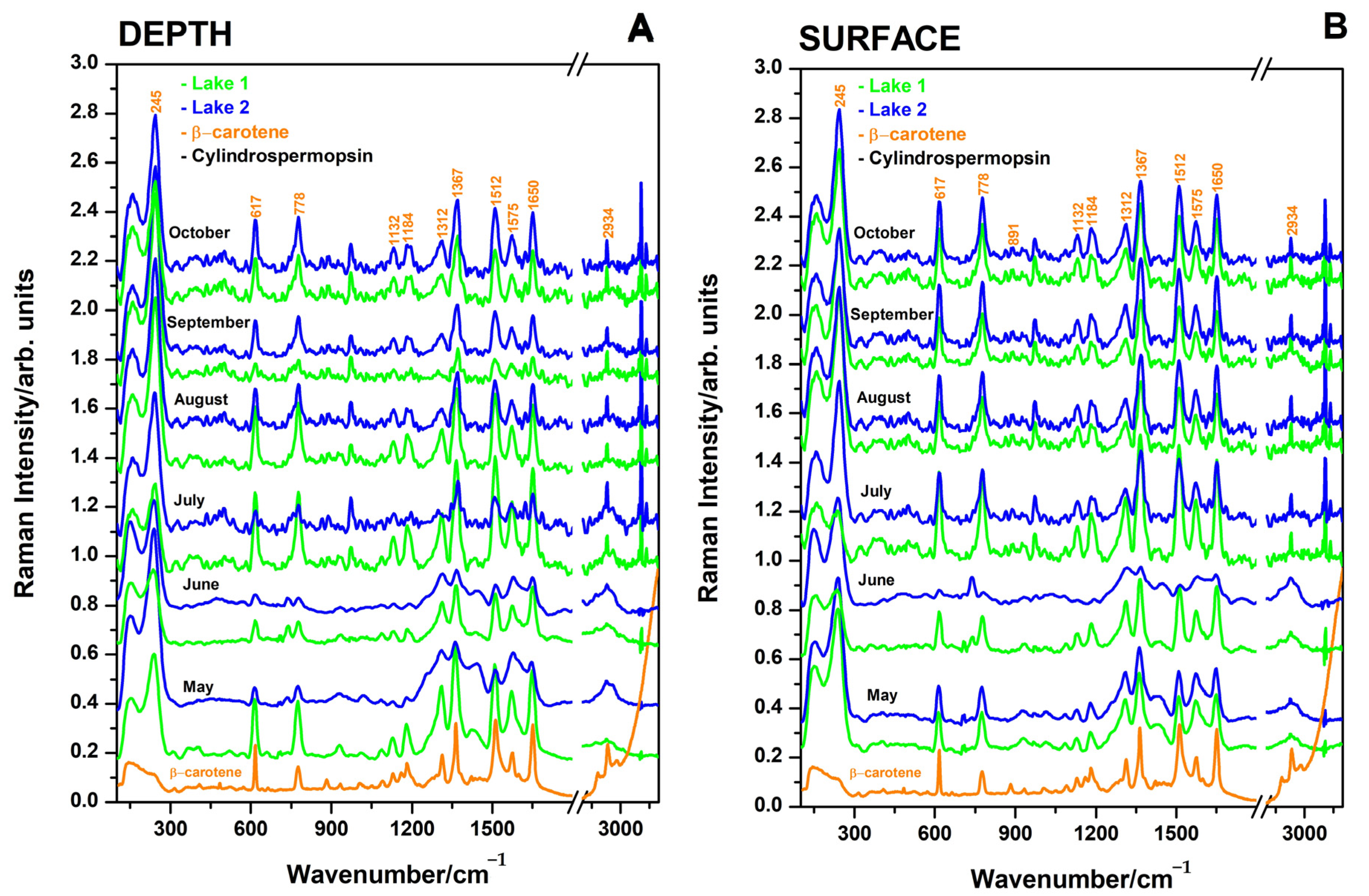
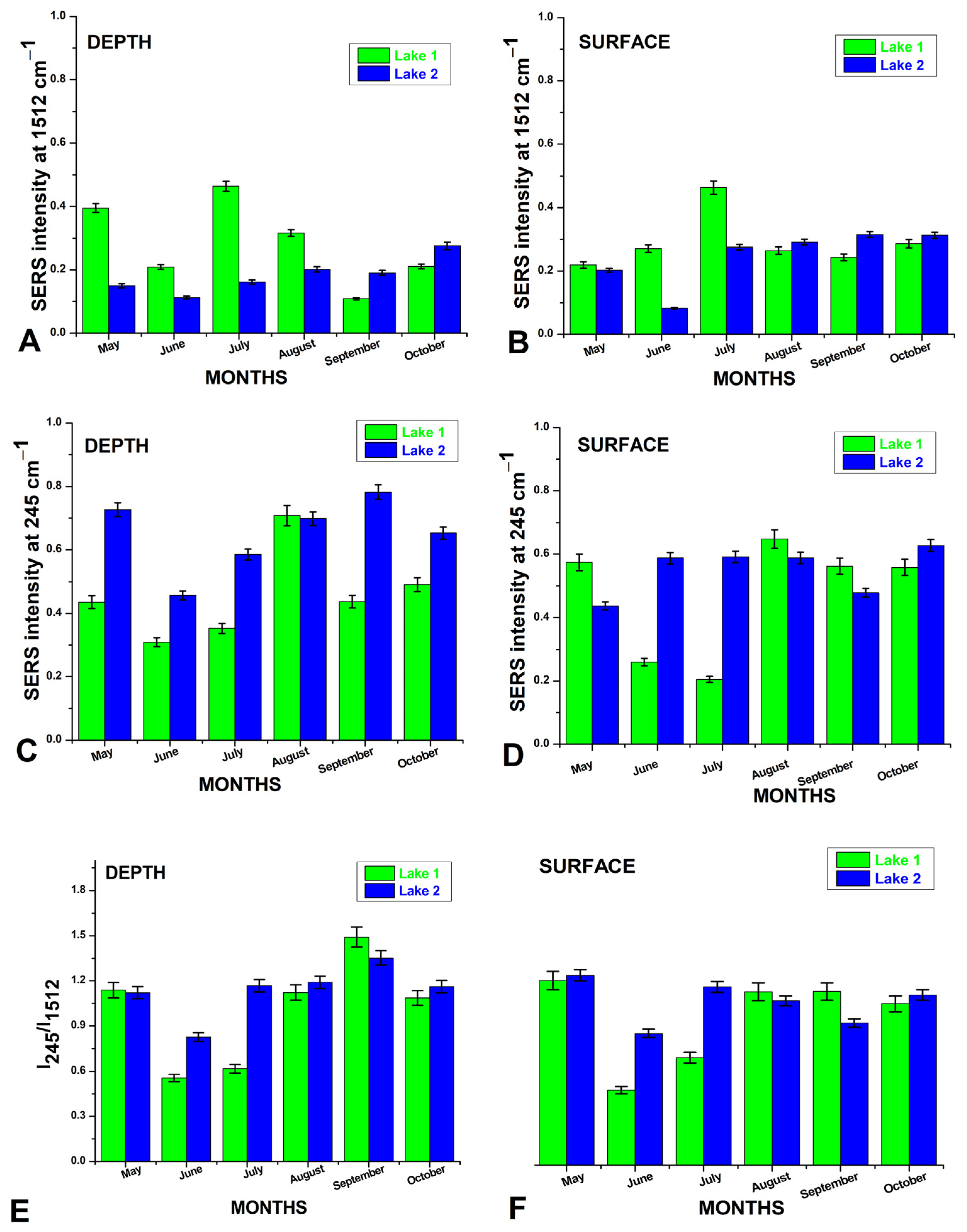
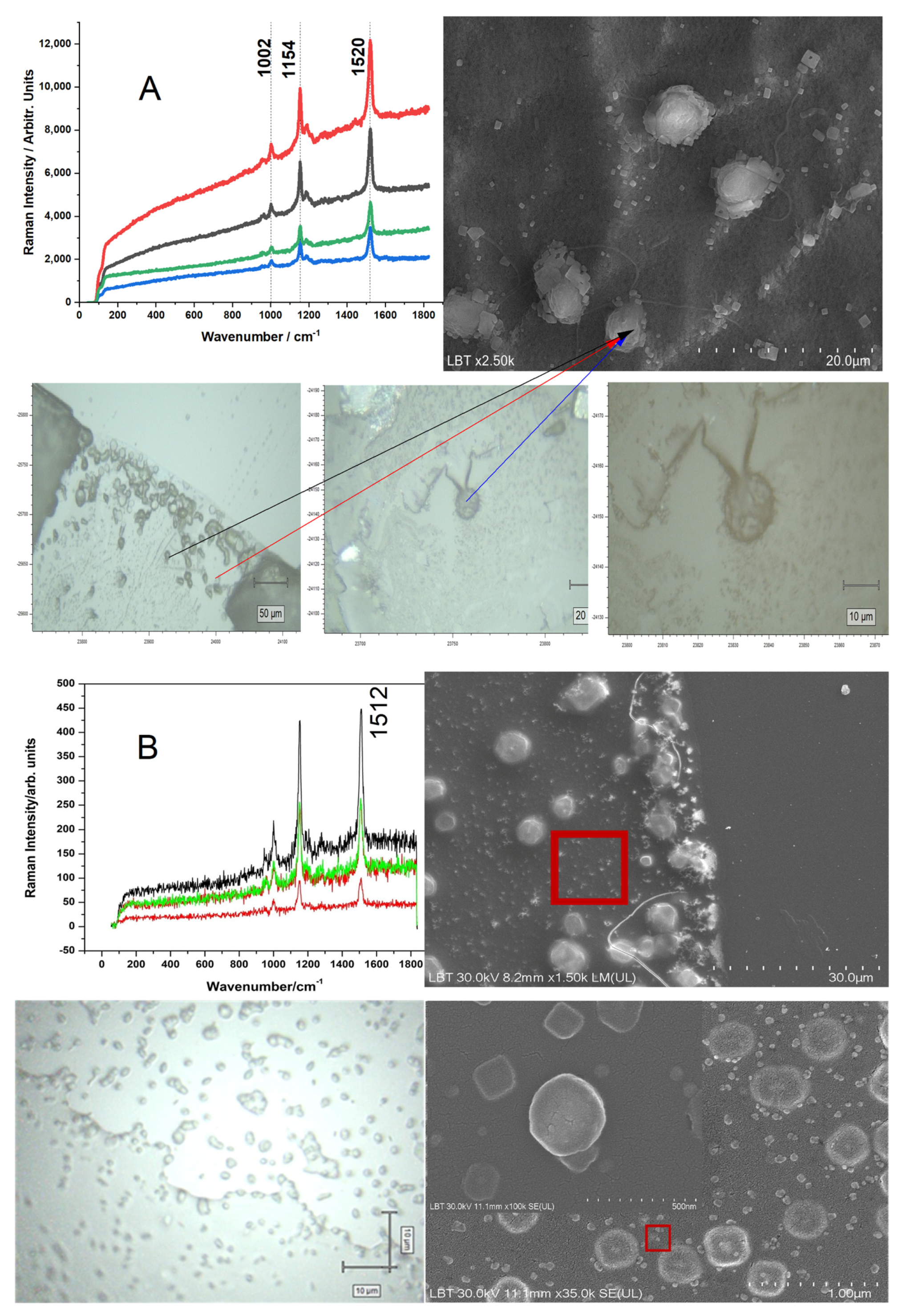


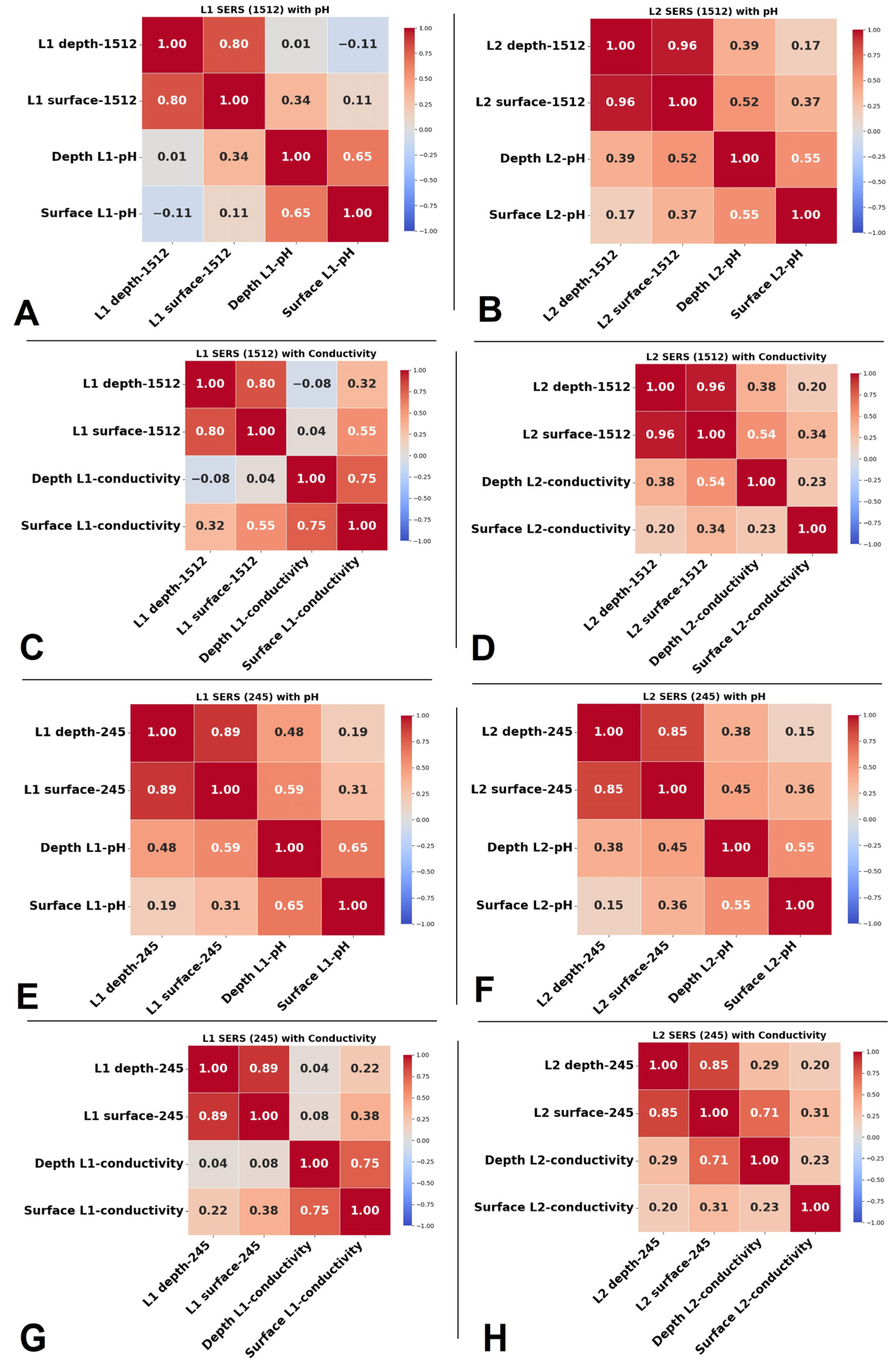
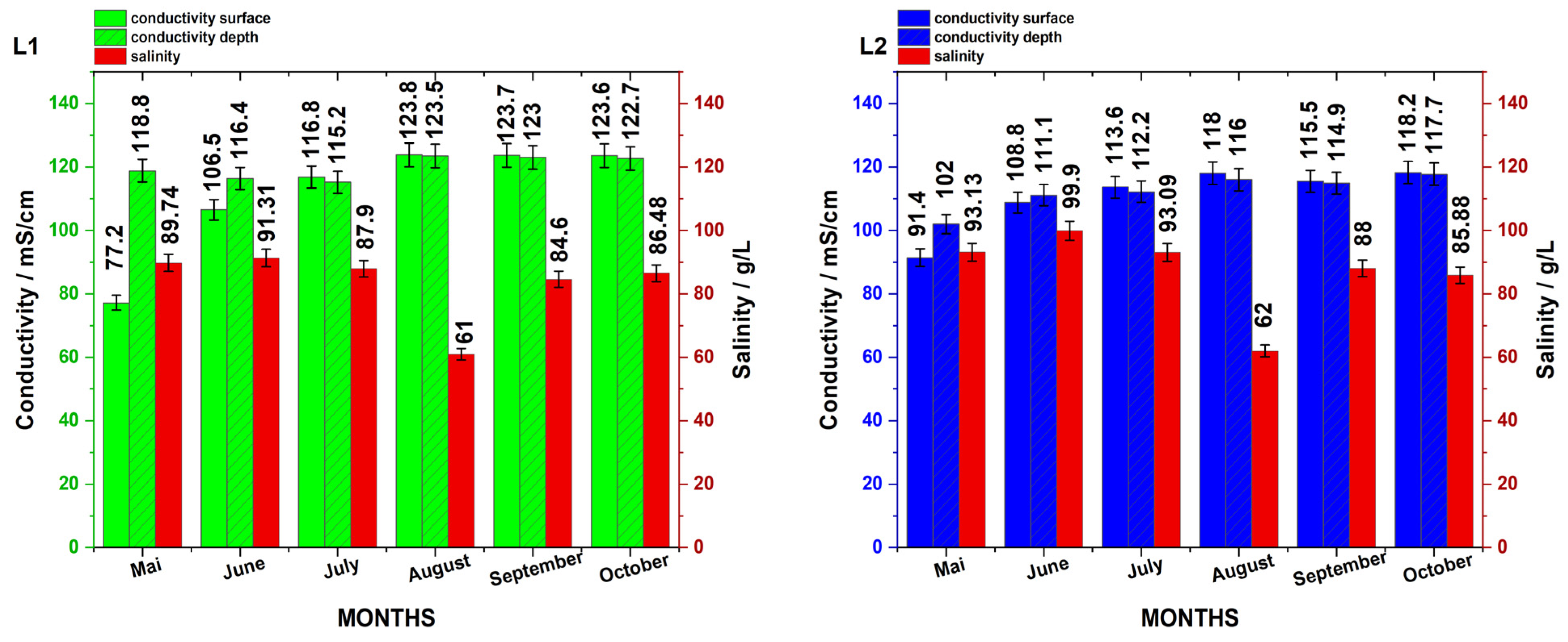
Disclaimer/Publisher’s Note: The statements, opinions and data contained in all publications are solely those of the individual author(s) and contributor(s) and not of MDPI and/or the editor(s). MDPI and/or the editor(s) disclaim responsibility for any injury to people or property resulting from any ideas, methods, instructions or products referred to in the content. |
© 2025 by the authors. Licensee MDPI, Basel, Switzerland. This article is an open access article distributed under the terms and conditions of the Creative Commons Attribution (CC BY) license (https://creativecommons.org/licenses/by/4.0/).
Share and Cite
Molnár, C.; Maškarić, K.; Barbu-Tudoran, L.; Tămaș, T.; Bajama, I.; Pînzaru, S.C. SERS Detection of Environmental Variability in Balneary Salt Lakes During Tourist Season: A Pilot Study. Biosensors 2025, 15, 655. https://doi.org/10.3390/bios15100655
Molnár C, Maškarić K, Barbu-Tudoran L, Tămaș T, Bajama I, Pînzaru SC. SERS Detection of Environmental Variability in Balneary Salt Lakes During Tourist Season: A Pilot Study. Biosensors. 2025; 15(10):655. https://doi.org/10.3390/bios15100655
Chicago/Turabian StyleMolnár, Csilla, Karlo Maškarić, Lucian Barbu-Tudoran, Tudor Tămaș, Ilirjana Bajama, and Simona Cîntă Pînzaru. 2025. "SERS Detection of Environmental Variability in Balneary Salt Lakes During Tourist Season: A Pilot Study" Biosensors 15, no. 10: 655. https://doi.org/10.3390/bios15100655
APA StyleMolnár, C., Maškarić, K., Barbu-Tudoran, L., Tămaș, T., Bajama, I., & Pînzaru, S. C. (2025). SERS Detection of Environmental Variability in Balneary Salt Lakes During Tourist Season: A Pilot Study. Biosensors, 15(10), 655. https://doi.org/10.3390/bios15100655







